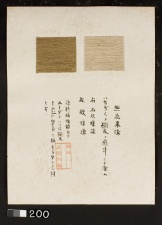Difference between revisions of "Ichijiku (Fig) - right (200 R)"
Jump to navigation
Jump to search
(username removed) |
(username removed) |
||
| Line 5: | Line 5: | ||
| 200 | | 200 | ||
|- | |- | ||
| − | ! scope="row"| | + | ! scope="row"|Uemura number / title |
| − | | | + | | ; "Haze-some 25" |
|- | |- | ||
! scope="row"|Folder location | ! scope="row"|Folder location | ||
| Line 44: | Line 44: | ||
| - | | - | ||
|- | |- | ||
| − | ! scope="row"| | + | ! scope="row"|Uemura's notes |
| − | | According to the Senryo shokubutsu fu ( | + | | According to the Senryo shokubutsu fu () published in 1972, Japan, bark of fig tree is recognized as dyestuff with tannin, and called Kili Bark in Sudan. |
|- | |- | ||
| − | ! scope="row"| | + | ! scope="row"|Uemura's date |
| Kyoto | | Kyoto | ||
|} | |} | ||
| − | [[Category: | + | [[Category:Uemura dye archive]] |
Revision as of 07:18, 24 July 2013
| Museum number | 200 |
|---|---|
| Uemura number / title | ; "Haze-some 25" |
| Folder location | 3rd shelf |
| Sample location | right (200 R) |
| Fiber type | silk |
| Color | pale brown |
| Dyestuff (Japanese common name) | いちじく : Ichijiku |
| Dye (English common name) | Fig |
| Dyestuff (botanical name) | Ficus carica L. |
| Plant part | bark / dried (?) |
| Dyestuff extraction | boiled in water |
| Auxiliary agent in dye bath | - |
| Mordant | lime water |
| Other auxiliary agent | - |
| Uemura's notes | According to the Senryo shokubutsu fu () published in 1972, Japan, bark of fig tree is recognized as dyestuff with tannin, and called Kili Bark in Sudan. |
| Uemura's date | Kyoto |
